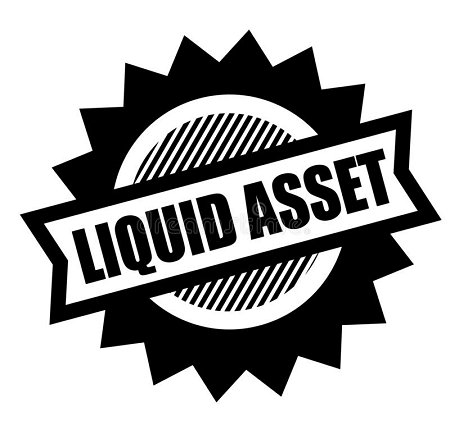What Is a Liquid Asset?An asset that can be quickly and easily converted into cash is called a liquid asset. Cash, instruments from the money market, and marketable securities are a few examples of liquid assets. For both individuals and businesses, keeping track of liquid assets as a proportion of net value can be challenging. Liquid assets are categorised as current assets on a company's balance sheet for financial accounting purposes. 
A liquid asset must typically meet several requirements in order to be deemed liquid. It must be in a well-established, liquid market where there are plenty of buyers on hand. Furthermore, it must be simple and safe to transfer ownership. The time it takes to convert a transaction into cash can occasionally change. Cash-in-hand and securities that can easily exchange for cash are the most liquid assets. Businesses may also consider assets with a cash conversion forecast of one year or less as the liquid. These assets collectively refer to a company's present assets. As a result, inventory and accounts receivable are now included in the definition of liquid assets. Accounting for Balance SheetsLiquidity states that assets are divided into current and long-term holdings using a hierarchical method on the balance sheet in financial accounting. Within a year, a corporation may use its existing assets to convert into cash. Depending on the type of asset, current assets have different times for converting their equity into cash. Cash is considered the most liquid version of a liquid asset because it is always available to use. Cash is considered legal money and can be used by an individual or business to settle financial obligations. Marketable securities and cash equivalents are the next types of investments that can be converted into cash in a brief period of time, usually immediately on the open market. Inventory and accounts receivable are two more current assets that can be considered liquid. As assets go up the balance sheet, they become less liquid. As a result, non-liquid assets are included in the balance sheet's long-term assets section. In a year or longer, these assets should be converted to cash. Non-liquid assets include land, real estate investments, equipment, and machinery because they can take a long time to convert to cash, can be expensive to convert to cash, or may not convert at all. Illustrations of Liquid AssetsExamples of liquid assets that both people and companies may own include: Currency and its EquivalentsGiven that it already exists as money, cash is the most liquid asset that is conceivable. This applies to actual cash as well as the contents of checking and savings accounts. It also includes international currency, but some of it could be challenging to convert to a more prevalent local currency. Due to their minimal risk (or insurance coverage) and brief lifespan, cash equivalents are another type of asset holding that can be considered similar to cash. Cash equivalents include things like Treasury bills, Treasury notes, commercial paper, certificates of deposit (CD), and money market funds. Be careful that some products may have reduced liquidity based on certain terms. Some CDs, for instance, are impenetrable or have severe consequences for ending early. Trading SecuritiesDepending on the underlying asset, some marketable securities are also considered liquid. Stocks, bonds, preferred stocks, index funds, and ETFs are a few examples. Futures and options are examples of additional instruments. Their holding period is a crucial factor in determining a marketable security's liquidity. Quick conversion to cash is required for liquid assets; however, depending on the safety, this isn't always attainable. Be aware that some investments are technically not considered current assets and must be shown on the balance sheet as long-term assets. Accounts ReceivablesA contentious class of liquid assets is accounts receivable. On the one hand, a business often has a legal right to money owed to them as part of its activities. It's possible that a customer used credit to purchase a product; after the credit period expires, the business is entitled to receive payment in cash. Accounts receivable balances, on the other hand, might not be collected. Additionally, it could take a surprisingly long time to get paid by a late client. Be mindful that a corporation might not be able to collect the entire amount of its accounts receivable balance when looking at them as liquid assets. InventoryInventory is another current asset that is challenging to evaluate. When it comes to a product in high demand and with a large market with visible markets, inventory may occasionally be regarded as a liquid asset. Take the newest iPhone as an example; any currently listed as inventory versions may suddenly be in demand by the market. Alternatively, what if the iPhone's demand declines? What if a new model is released, and Apple is left with outdated stock? What happens if the central warehouses are broken, and most of the stock is taken? Theoretically, inventory is a liquid asset because normal business processes result in its conversion to cash. However, inventory might not be as liquid if a recession hits or any of the aforementioned events occur. Examination of Liquid AssetsManaging liquid assets in business for internal performance and external reporting is crucial. A company with more liquid assets can better meet its debt commitments as they come due. 
Companies manage their balance sheet funds to pay bills and order essential expenditures using strategic methods. Businesses operating in sectors like banking must maintain a minimum balance of cash and cash equivalents to meet regulatory requirements. Numerous essential measures, often known as solvency ratios, are used by analysts to evaluate liquidity. The quick ratio and the current ratio are two of the most popular. Existing assets are used in the current balance to assess a company's capacity to pay all its current liabilities and survive unforeseen and exceptional conditions like a pandemic. The quick ratio is a more stringent indicator of solvency because it assesses a company's ability to pay all of its current creditors with its most liquid assets. The quick ratio includes accounts receivable. Markets: both Liquid and Non-LiquidBoth individuals and companies deal with markets that are liquid and non-liquid. The ultimate goal of liquidity is cash, and the ease of converting assets into money typically distinguishes between liquid markets and those that are not. Still, there may also be some additional factors to take into account. An established market with enough buyers and sellers must exist for an asset to be considered liquid for it to turn into cash quickly. Additionally, the asset's market value shouldn't undergo significant changes that may reduce or increase the liquidity for later market players. Since there are many buyers and sellers on the stock market, it is an example of a liquid market and allows for simple conversion to cash. Equities that are publicly traded can be sold at any time for total market value using electronic markets, making them liquid assets. However, depending on market size and the typical share volume of transactions, liquidity can differ for each security. Since trillions of dollars are exchanged in the foreign exchange market every day, around-the-clock, it is thought to be the most liquid market in the world because no single person can control the exchange rate. Some other liquid markets include those for commodities and secondary market debt. Unstable MarketsIlliquid markets have unique concerns and limitations. When choosing between liquid and non-liquid assets and making investment decisions, these characteristics may be significant for both individuals and investors. For instance, a homeowner may wish to sell their house in order to settle their debt. Although it is less liquid than the stock market, the liquidity of the real estate market can vary depending on the property and the market demand. As a result, the owner might have to accept a lower price in order to sell the house swiftly. Rapid sales may not always result in the total market value as expected and may have a negative impact on market liquidity. Private market fixed income is another sort of contentious illiquid asset that can be liquidated or sold, though in a less active manner. Investors typically use a liquidity premium when analysing illiquid assets, which calls for a greater yield and return in exchange for the risk associated with liquidity. Requirements for Liquid Asset ValueThe value of liquid assets may be subject to requirements for some businesses or organisations. This restriction is in place to safeguard the company's short-term viability and the safety of its customers. To qualify as FHA-approved lenders, banking institutions must meet the liquid asset requirements set forth by the U.S. Department of Housing and Urban Development. For instance, non-supervised mortgagees must maintain a minimum of $200,000 in liquid assets. Lending institutions are required to have a certain amount of unencumbered liquid assets on hand, according to the Federal Deposit Insurance Corporation (FDIC). It also describes the policies that must be followed when institutions must have more liquid assets, such as when recent trends show significant decreases in large liability accounts, the loan portfolio contains a substantial portion of non-marketable loans, or the institution's access to capital markets is hampered. Last but not least, there have been adjustments recommended for money market funds by the Securities and Exchange Commission (SEC). According to Rule 2a-7, after the acquisition of an asset, a money market fund shall hold at least 10% of its total assets in daily liquid assets and 30% of its total assets in weekly liquid assets. With new recommendations, the daily and weekly fluid asset thresholds are being raised.
Next Topic4 Factors That Shape Market Trends
|
 For Videos Join Our Youtube Channel: Join Now
For Videos Join Our Youtube Channel: Join Now
Feedback
- Send your Feedback to [email protected]
Help Others, Please Share









